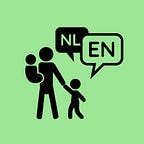Language development: Defining terminology
In this blogseries I will talk about the language development or acquisition of a child, both monolingual and bilingual (or multilingual). Before I dive into the subject in my posts, here is a introductory post about the different stages and other terminology I use. Other posts can use similar or different terminology, but overall I know that the information itself is consistent.
Age notation
Please note that ages are indicated in years;months. For example, 2;6 years means 2 years and 6 months. Ages can also be indicated in years or months only.
Different stages in language development
Language development can be described in many ways and with many differently defined stages. Some use ages in full years as stages, others look at the linguistic developmental stages. No matter which way you prefer, they all contain the same information. In my blogposts about this subject, I will use the following stages:
- Early language stage (1–2;6 years)
- Stage of linguistic differentiation (2;6–5 years)
- Stage of linguistic completion (5+ years)
Terms used in language development
In earlier posts I have already talked about different ways a child can grow up with 2 or more languages. When talking about bilingual development, several different terms and abbreviations are used. There are three main terms that will be used in my blogs that I will explain here, and each includes a different way of referring to the languages that are being acquired.
Monolingual language development
- Monolingual means only one language.
- The abbreviation used is MFLA, which means Monolingual First Language Acquisition
- The language being acquired is referred to as Language 1.
Bilingual development for simultaneous bilinguals
- The child acquires all languages since birth.
- The abbreviation used is BFLA, which means Bilingual First Language Acquisition
- The abbreviation TFLA is normally used for Trilingual First Language Acquisition. Whenever I refer to bilingual people, I also refer to multilingual people so I generally don’t use this term.
- Languages are referred to as Language A, Language B, Language C etc. (LA, LB, LC)
Bilingual development for sequential bilinguals
- The childs acquires or learns a language after the first one is already acquired.
- The abbreviation used is ESLA or SLA, which means Early Second Language Acquistion, or only Second Language Acquisition when the child is even older.
- Languages are referred to as Language 1, Language 2, Language 3 etc. (L1, L2, L3)
Bilingual development for combined simultaneous and sequential
- The child acquires two or more languages from birth, and also learns another language later in life
- The abbreviation used are also BFLA or ESLA, depending on the specific situation and language described at that moment.
- Languages are referred to as follows: Language 1A, Language 1B, Language 2 (L1A, L1B, L2A, L2B, L3).
Originally published at https://intentionallybilingual.weebly.com.
